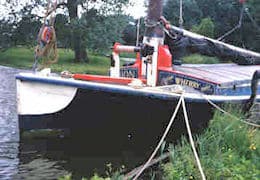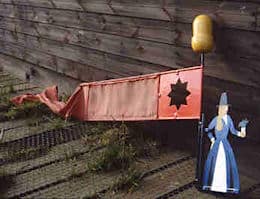East Anglian traditional Norfolk Wherries
In East Anglia the Norfolk Broads form a separated and isolated network of lakes and rivers, connected to the sea at Yarmouth and Lowestoft by the rivers Yare and Waveney.
Small coasters can penetrate 30 miles inland to Norwich, but the remaining seventy miles of navigable waters are the preserve of thousands of pleasure cruisers and the last two Norfolk ‘wherries’ in commission.
Square rigged keels were once the commonest trading boats of East Anglia, descendants it was thought of the Viking ship tradition. But in the nineteenth century the Norfolk Wherry became the indigenous trading craft of the Broads.
Wherries were all built to a similar pattern, but in a variety of sizes depending on their area of operation. Usually clinker built, with overlapping planks ‘clenched’ together to make them water tight, they were shallow-draft broad-beam barges with a two man crew, and were driven by a single loose footed gaff mainsail, so darkly tanned as to be almost black.
The unstayed mast was hinged above deck level in a tabernacle mast box so that it could be lowered back onto the hatches to pass under low bridges. It was winched up again using a pulley block on the forestay but to make it easier the bottom of the mast was fitted with a massive counter weight which swung down through a trough in the foredeck until it slotted into the base of the mast box.
A few were eventually motorised, but the majority remained under sail until commercial wherry traffic finished in the 1950’s. Today just two remain, the Albion operated for over sixty years by the far-sighted Norfolk Wherry trust, and the Maud, finally sailing after a long private restoration.
In addition there are still several pleasure wherries sailing the Broads, boats built in the traditional way with the traditional rig, but fitted out as elegant pleasure cruisers. These too are a traditional pleasure to see.
Fenland Lighters
The Fenland waterways form a network of rivers and artificial water channels that drain vast areas of low lying eastern England into the Wash and the North Sea. They run from Cambridge and Bedford in the south to Lincoln in the north, with the River Nene providing a link to the canals at Northampton.
The Lincolnshire waterways of the Witham tended to favour a style of barge like the Yorkshire Keel but the more southerly areas developed the idea of trains of smaller lighters, working together as a gang. The leading lighter was rigged with a square sail and towed two or three more behind it. They were steered from the first boat of the chain by a massive pole projecting from the bows of the second one. This ‘bowsprit was therefore something like a tiller, with the whole of the second boat acting as a huge rudder, whilst the remaining boats in the gang trailed along behind. Surprisingly the same steering principal was used when sail gave way to horse towing and latterly to motor tugs. It sounds like hard work and rather clumsy, but it worked well in narrow channels, through a variety of lock sizes and around sharp junction corners. The barges of John Constable’s River Stour paintings worked in pairs with a similar steering system and one of those ancient lighters has been recently restored for posterity. Gangs of wooden fenland lighters were in traffic until 1945, whilst longer gangs of steel lighters working behind tugs were still employed in the sugar beet trade in the 1960s.
All materials and images © Canal Junction Ltd. Dalton House, 35 Chester St, Wrexham LL13 8AH. No unauthorised reproduction.
About | Terms | Privacy| Refunds & Returns| Sitemap | Contact Us
With over 800 pages, this website uses cookies to record visitor behaviour using Google Analytics. More information on Privacy Page. Page last updated: 31/03/2025.




Back to Menu....
Narrowboats & Barges >>
Canal Heritage >>